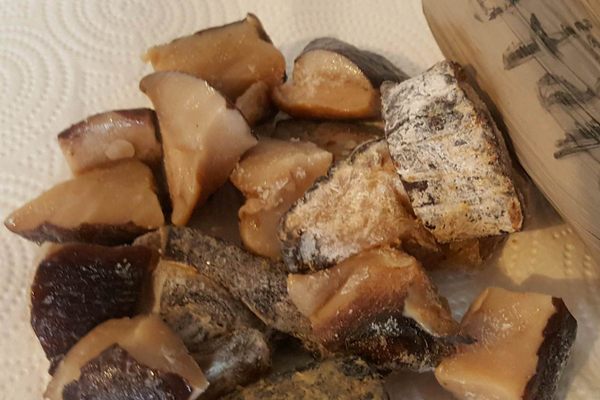Kānga pirau is a fermented corn porridge with a texture like hummus. It has an earthy flavor, with distant notes of blue cheese, and can be eaten on its own with brown sugar and cream or worked into a muffin recipe. But no matter how it’s prepared, kānga pirau has a distinct “vomit-like” smell that scares some would-be consumers away from what is otherwise a tasty, or at least palatable, dish.
The foul smell stems from the fermentation process. When Western colonialists arrived in New Zealand, they brought a variety of crops and animals. Indigenous Māori embraced these culinary opportunities, using them in new ways to produce unique dishes. Corn grew easily, but was available only in the summer. By fermenting the kernels, however, they could make the crop last through the cold, leaner months.
Kānga pirau is produced by placing whole corn cobs into sacks and then leaving them submerged in fresh running water. Modern techniques sometimes circumvent the need for a natural site by using plastic drums and pipes, especially as many rivers are now too polluted for the original method to be safe. Either way, the cobs are weighed down and left until they’ve fermented, which usually takes between six weeks and three months.
Once the kernels have softened enough, they’re scraped off the cob and mashed into a yellow mush. You can eat the resulting paste alone or mix it with the washed ash of the native manuka tree (modern cooks tend to use baking soda instead) to make kānga pungarehu, a sweeter delicacy.
These days, kānga pirau is not easy to find, thanks to later colonialism’s stamping out of Maori culture, through the combination of Victorian missionary efforts and a move away from growing one’s own food. But after a cultural renaissance sparked new interest in old ways, including Māori language and cuisine, kānga pirau reemerged. It might not be readily available, but those who love it will go out of their way to find it, usually at Māori cultural fairs. Otherwise, it’s sold for a koha, or donation, in areas with large Māori populations like Taranaki or Northland.
Written By
 natashafrost
natashafrost
Sources
- www.wcl.govt.nz/blog/index.php/2014/02/24/naku-te-rourou-rewena-starter-diary-or-a-bewildered-beginning/
- curiouskai.blogspot.com/2007/02/kawhia-traditional-maori-kaifood.html
- www.nznewsuk.co.uk/living/?id=5583
- www.stuff.co.nz/taranaki-daily-news/news/75802513/taranaki-mans-rotten-corn-dish-passes-the-taste-test
- www.stuff.co.nz/dominion-post/oddstuff/75616921/Revival-of-rotten-corn-a-real-labour-of-love-for-one-Waitara-man
- www.newzealand.com/int/feature/indigenous-maori-food-ingredients/
- link.springer.com/article/10.1007/BF02885665
- link.springer.com/chapter/10.1007/978-1-4899-7671-0_10














